

How to Write a Good Academic Biography (Part 1)
When your journal article gets accepted or you are preparing for a public presentation, you will often be asked for a short academic biography. For many people, these academic bios are more difficult to write than a dissertation. How do you sum up yourself and your work in 3-5 sentences? What do you need to include? What should you leave out?
What You Should Do
- Start with your full name followed by your current position, your general interests, and your current project, keeping them all very brief.
- If you are within a year of receiving a prestigious award, mention that as well.
- Finally, finish with a sentence that’s personal: add a hobby, a pet’s name, the city you live in—whatever you are comfortable with that is personal but not too private.
What You Should Avoid
- Avoid speaking in the first person, i.e., don’t use “I.”
- Don’t divulge details beyond your current position.
- In a longer bio of multiple paragraphs, you may add more awards and information about your master’s and bachelor’s degrees, but not in a short bio. Moreover, don’t add anything that happened before grad school—including your place of birth. For example:
Hi! My name is Scott. I was originally born in Vermont and now I’m a professor at North Yankee University in Fargone, New York (in upstate New York). I study antelopes’ migration patterns and their impact of native grain growth. My interest in antelopes began as a teenager when I first saw one in the wild. I did my undergrad degree in biology at SUNY and my masters and UCLA and my PhD in Forestry at Hunter College.
Related: Finished drafting your academic biography and heading for an international conference? Check out this post now!
The above example is far too casual and Scott’s work and current position are overshadowed by all the other random details. This can be written in a much better way:
Scott Sampson is a professor of Wildlife Biology at North Yankee University. His work focuses specifically on the migration patterns of antelope and their impact on the growth of native grain. His favorite place to do research in his backyard, which opens to the Akron National Forest.
This improvised version is concise, relevant, and makes Scott’s bio appear professional while giving a short description of his personal details.
Longer Bios
For longer bios, follow the same basic rules, but go into a bit more depth about your work, your education, and your future projects or interests. You may also consider adding a line about your immediate family. But as always, leave the personal details for a short and friendly mention at the end of the bio.
Mostly, your bio will be used by someone to introduce you at a conference or public event so if you write your bio using these tips, you will help them give a smooth and accurate introduction. Remember that the bio is the first thing that people know about you so pack it full of the most important things about yourself!
If you would like to know more about different formats of academic biography, read the next article in this series!
Appreciating the dedication you put into your blog and detailed information you provide. It’s good to come across a blog every once in a while that isn’t the same out of date rehashed material. Fantastic read! I’ve bookmarked your site and I’m including your RSS feeds to my Google account.
Greeting from Enago Academy! Thank you for your positive comment. We are glad to know that you found our resources useful. Your feedback is very valuable to us. Happy reading!
Super helpful! Thank you for writing about this.
wow great article. I got lots of new ideas from this post. Thanks a lot.
Thank you! Really a short and precise description of how to write short biographic sentence.
Excellent! Just what I needed; thank you.
Thanks for sharing this post, It is a very helpful article.
Excellent information…
Comparing to my introduction and yours, there is a huge difference and mine is like grade R?. Thank you so much for developing such content and helping disadvantaged students like me, hence holding Honours. Once again thank you
it is good, i learnt something new
Your articles are so much meaningful and informative.
Rate this article Cancel Reply
Your email address will not be published.

Enago Academy's Most Popular Articles

- Manuscripts & Grants
- Reporting Research
How to Write a Good Academic Biography (Part 2)
Writing an academic biography is part of many academic activities. Whether your paper is accepted…

Sign-up to read more
Subscribe for free to get unrestricted access to all our resources on research writing and academic publishing including:
- 2000+ blog articles
- 50+ Webinars
- 10+ Expert podcasts
- 50+ Infographics
- 10+ Checklists
- Research Guides
We hate spam too. We promise to protect your privacy and never spam you.
- Industry News
- Publishing Research
- AI in Academia
- Promoting Research
- Career Corner
- Diversity and Inclusion
- Infographics
- Expert Video Library
- Other Resources
- Enago Learn
- Upcoming & On-Demand Webinars
- Open Access Week 2024
- Peer Review Week 2024
- Conference Videos
- Enago Report
- Journal Finder
- Enago Plagiarism & AI Grammar Check
- Editing Services
- Publication Support Services
- Research Impact
- Translation Services
- Publication solutions
- AI-Based Solutions
- Thought Leadership
- Call for Articles
- Call for Speakers
- Author Training
- Edit Profile
I am looking for Editing/ Proofreading services for my manuscript Tentative date of next journal submission:

What factors would influence the future of open access (OA) publishing?
CV for PhD application example
You’ve wrapped up your degree and are keen to embark on your PhD journey.
But before you can get stuck in, you’ll need to secure your place by putting forward a compelling PhD application and CV.
If you’ve never written an academic-style CV before, the process can be daunting. That’s why I’ve created this step-by-step guide to writing a CV for a PhD application.
I’ve also included a PhD CV example, to give you a better idea of what you need to include. Here’s what I’ll cover in the guide:
Guide contents
PhD application CV example
- Structuring and formatting your CV
- Writing your CV profile
- Detailing your education
- Detailing your relevant experience
CV templates
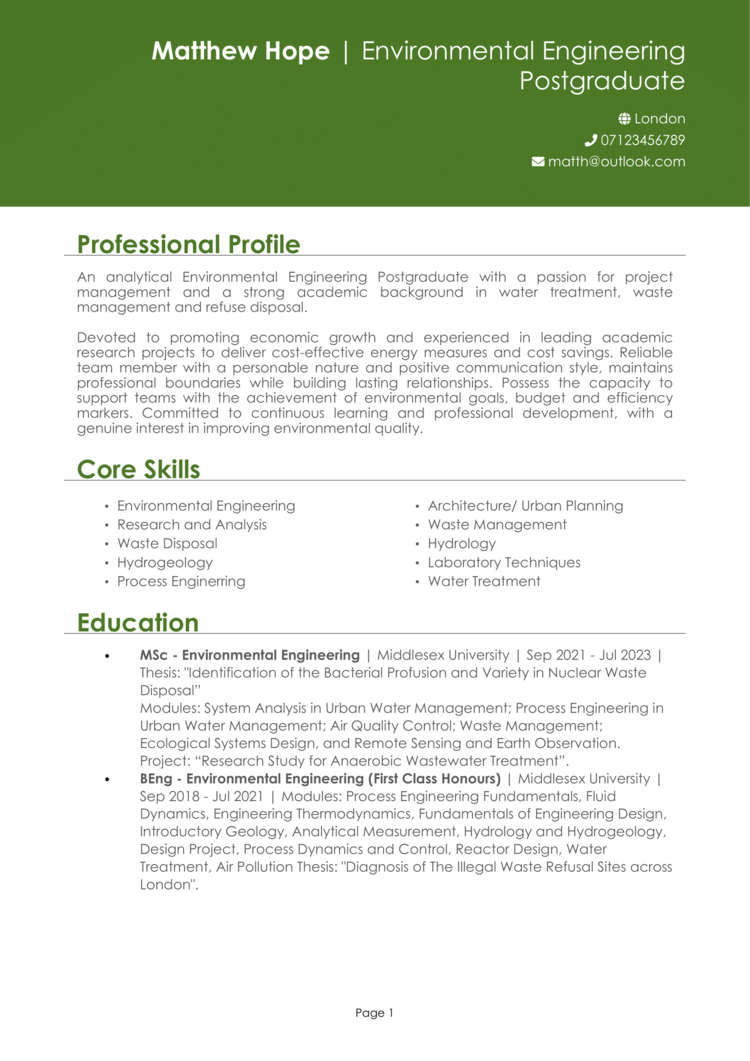
As you can see from the CV example above, a PhD CV is structured differently to a traditional CV. Instead of focusing on work experience, academic experience and accomplishments are prioritised.
However, the fundamental CV writing rules stay the same. Therefore, the candidate has put forward their information in a way which is clear, concise and formatted for easy reading.
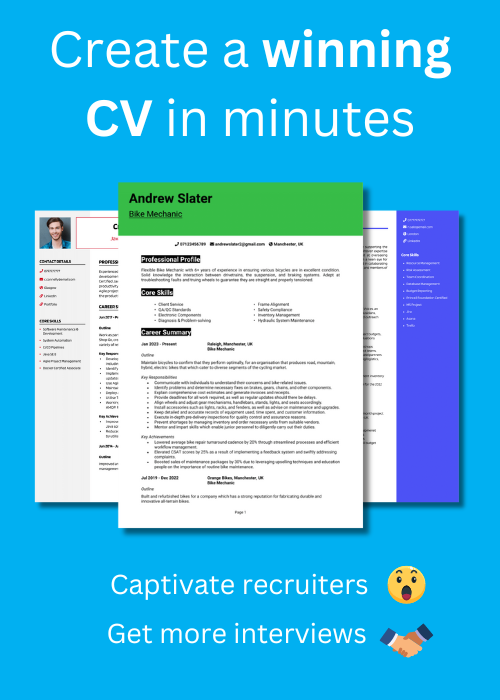
Build your CV now
PhD application CV structure & format
PhD programmes receive thousands of applications, meaning the university admissions teams are generally very time-strapped.
As such, you need to structure and format your CV to make it as easy as possible for them to review.
First impressions count and a cluttered or disorganised application won’t do you any favours.
Instead, you should aim for a clean, well-organised and professional appearance throughout.
Formatting Tips
- Length: While academic CVs are generally longer than standard CVs, it’s still best to aim for a short, relevant and concise document. For PhD applications, a length of one or two A4 pages is ideal. This is more than enough space to highlight your suitability without overwhelming the reader with irrelevant information or excessive detail.
- Readability: The information on your CV should be laid out logically, with clear section headings for easy navigation. Break up large chunks of text into small, snappy paragraphs and include bullet points where appropriate.
- Design: Opt for a clear, legible font and stick to it throughout – consistency is important. Ensure your headings are formatted for attention by using bold text or a slightly larger font size.
- Things to avoid: Steer clear of elaborate designs, fancy fonts, images or logos – they’re simply not needed and might distract from the all-important written content.
- Things to consider: CVs ‘rules’ differ from country to country, so if you’re applying to an international university, take some time to research what’s expected of you.
Structuring your CV
Organise your content into the following sections for ease-of-reading:
- Contact details – These should always be at the very top of your CV.
- Personal statement – A brief introductory summary of your qualifications, skills and experience in relation to the PhD.
- Core skills – A short and snappy list of your most relevant skills, tailored to the PhD.
- Education – A detailed breakdown of your relevant qualifications, especially your undergraduate and postgraduate degree(s).
- Career summary/research experience – An overview of any relevant work or research experience, angled towards your chosen field of study.
- Additional information – A space to detail any other relevant information which may boost your application.
Quick tip: While the simple CV format above is usually ideal, academic institutions often have their own preferred structure. Double-check their guidelines before you start writing – their preferences should be prioritised – and use a CV template if you want to speed things up without sacrificing quality.
CV Contact Details
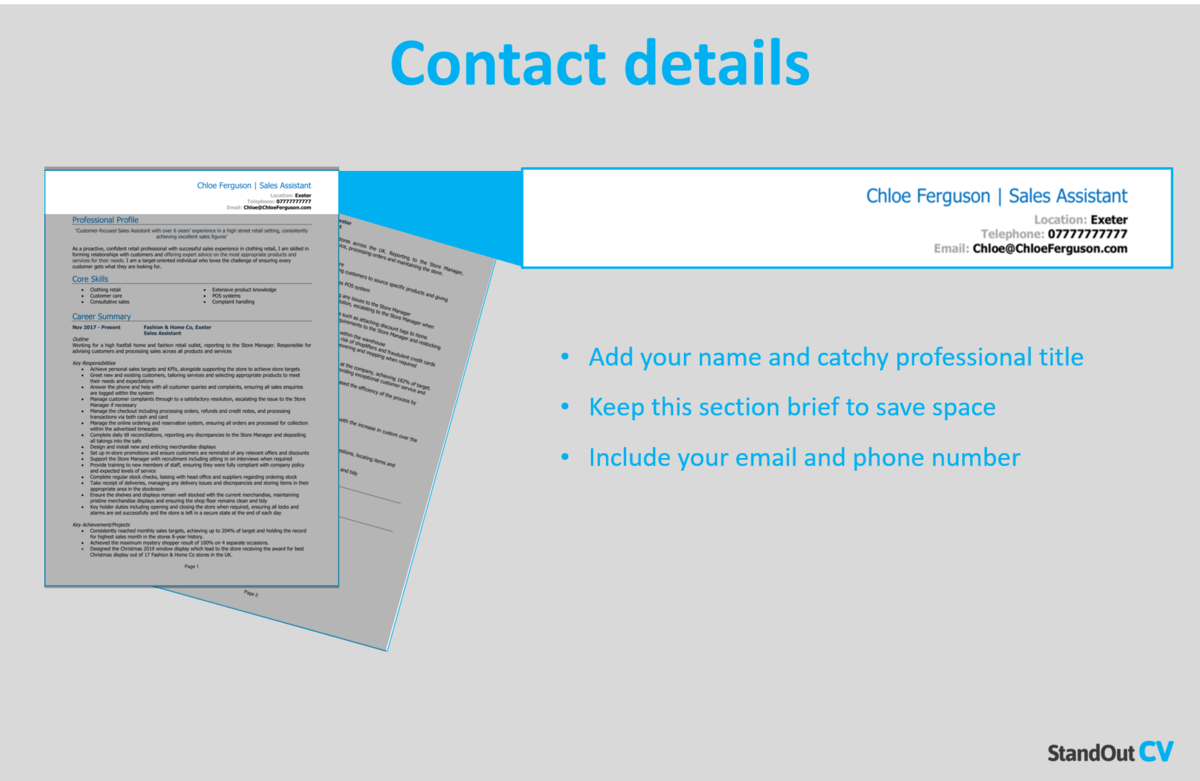
Commence your CV by sharing your basic contact details
- Phone number
- Email address
- Location – Rather than listing your full address, your town or city, such as ‘Manchester’ or ‘Exeter’, is enough.
- If you have one, add a link to your LinkedIn profile or a portfolio of work.
CV for PhD Personal Statement
Your profile / personal statement is essentially your first impression on the reader and is a great way to hook their attention.
It should provide a snappy summary of who you are and why your qualifications, skills and ambitions make you a perfect candidate for the PhD.
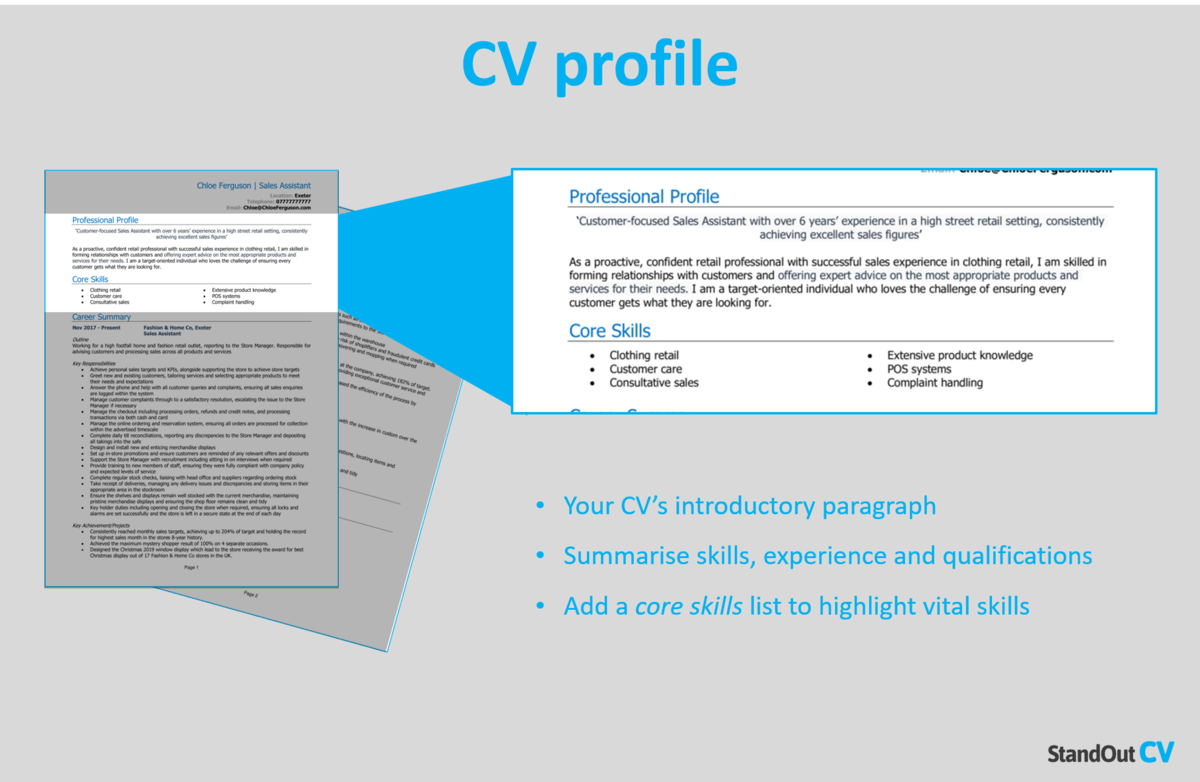
Tips to consider when creating your personal statement:
- Tailor to the PhD: Every PhD programme should have a description available, which you can use to tailor your personal statement ( and your CV as a whole). Focus on proving you have the appropriate educational background, skillset and knowledge to carry out the project.
- Prove your enthusiasm: It’s important to put forward your drive and motivation for your field and explain why the specific PhD is so well-matched to your wider interests and ambitions.
- Avoid clichés: Clichés and generic phrases like “I’m a motivated team player” and “gives 110%” won’t impress the admissions team.
- Keep it short: A paragraph length of around 8-15 lines is perfect. This is only an introduction – the detail can come later on in your CV.
What to include in your CV for PhD personal statement?
- Your academic background – Give a brief overview of your undergraduate degree and/or masters and how they’ve brought you towards this PhD.
- Impressive results – PhD students are normally academically extraordinary, so make sure to point out any impressive results or feedback – whether that’s your degree as a whole or a particularly relevant assignment/project grade.
- Relevant skills – Use the PhD project description to find out what the university is looking for in candidates. Then, try to incorporate the core skills into your profile.
- Relevant experience – Not everyone will have any relevant research or work experience to their name at this stage, but if you do, make sure to briefly highlight it here.
- Interests, goals & motivations – Give a brief insight into your motivation for taking on a PhD, why you’re so committed to your specific research topics(s) and what you think you can add. It’s also helpful to summarise how the course will fit into your wider career ambitions/goals.
Core skills section
Next, create a punchy list of core skills, organised into 2 or 3 columns of bullet points.
Use the project description to identify the required skills and knowledge, then use your findings to inform your list.
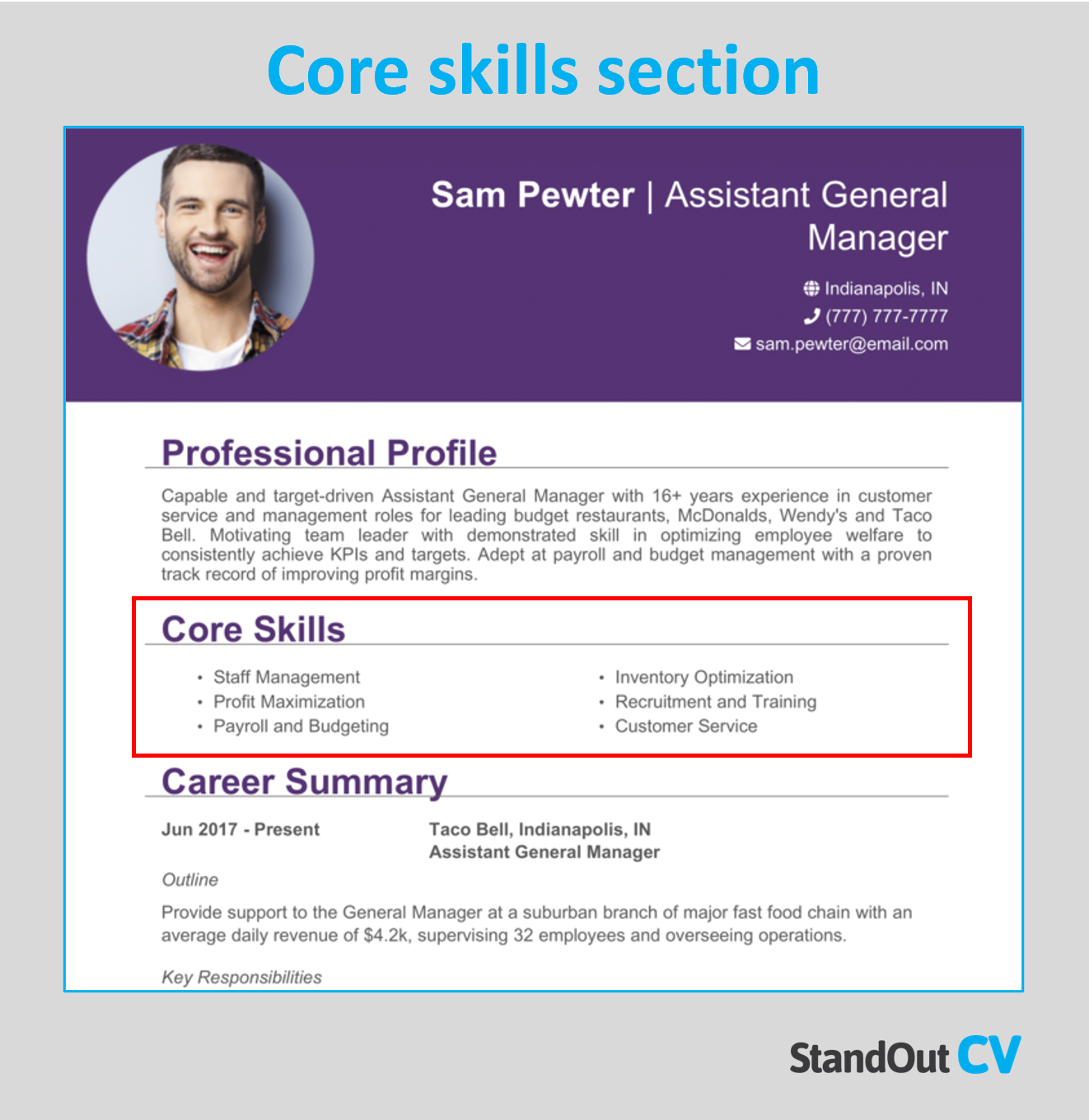
This will help the busy admissions team to see that the PhD is right for you at a glance.

Education & Qualifications
A PhD CV is all about academic achievements and qualifications, so this section should make up the bulk of your CV.
Working in reverse chronological order, provide a detailed breakdown of your undergraduate and postgraduate qualifications.
If you have any GCSEs, A-Levels or other academic qualifications that are particularly relevant to the PhD subject, they might be worth listing, too.
Structuring your education
By working to a considered structure, you can ensure your education is easy to navigate and that your key achievements stand out.
For each of your relevant qualifications, break up information into the following sections.
Start by detailing the type of qualification, the title, the achieved grade, the academic institution at which you studied and the year you graduated.
MSc – Environmental Engineering (Distinction)
Middlesex University (2018)
Course content
Next, discuss your thesis or dissertation title (if applicable), the modules you studied and any relevant projects you were involved in.
What you choose to write here should be tailored to the PhD you’re applying for – focus the detail on the most relevant aspects of the qualification.
Thesis: “Identification of the Bacterial Profusion and Variety in Nuclear Waste Disposal”.
Modules: System Analysis in Urban Water Management; Process Engineering in Urban Water Management; Air Quality Control; Waste Management; Ecological Systems Design, and Remote Sensing and Earth Observation.
Project: “Research Study for Anaerobic Wastewater Treatment”
Key achievements (optional)
Finish up with a snappy list of key results, accomplishments or learning outcomes you achieved.
This might be an impressive grade for a highly relevant assignment, an award you won or a quote of exemplary feedback from a tutor.
Career & Research Experience
Next up is your career & research summary, which should be tailored to the PhD in question.
You could include relevant research experience here, as well as any related employment (even if temporary or voluntary).
Make sure to be selective with the type of employment you list, though. For example, a part-time waiting on job isn’t worth including, but a laboratory or tutoring job might be. Ultimately, it should be related to your field or have helped you develop relevant skills or knowledge.
When discussing your research roles, make sure to detail the techniques you used, the skills developed and any interesting findings.
Structuring your experience section
Ensure your career & research section is clear, scannable and easy to read by working to the following structure:
Outline the dates of employment/contract, the role title and the organisation or institution you worked for.
Aug 2018 – Sep 2019 Research Intern Hydro Continental, London
Give a brief overview of the position or research project as a whole, discussing the team you worked with (or lead), who you reported to and what the goal of the project was.
“Undertook a short-term assignment pertaining to the Economics of climate change in order to research and drive improvements in energy consumption and emissions; reported to the Executive Engineer.”
Key responsibilities
Then use bullet points to pinpoint your duties and responsibilities within the role, making sure to mention any relevant techniques or skills used that could benefit your candidacy. E.g.
- Employed the Marginal Abatement Cost (MAC) curve tool to present carbon emissions abatement options.
- Built partnerships and participated in open discussions with other country modellers and research associates.
- Amassed and processed varied data from multiple sources.
Writing your CV for PhD
Applying for a PhD is a daunting yet exciting time, but a flawless CV can help you achieve your goals.
Remember to tailor your CV to the specific PhD you’re applying for and aim to make a compelling case for your suitability and aligned goals.
Before you send off your CV, try to get a second opinion from a current or previous tutor, trusted family member or friend.
It’s also worth checking the finished document with our quick-and-easy CV Builder , to eliminate the risk of overlooking mistakes.
Best of luck with your PhD application!
- Resume Writing
- Resume Examples
- Cover Letter
- Remote Work
- Famous Resumes
- Try Kickresume
CV for PhD Application: How to Write One Like a True Scholar (+CV Example)
- Klara Cervenanska ,
- Updated March 13, 2024 11 min read
A PhD is the highest level of academic qualification you can achieve. To secure your position, however, you first need an impressive CV for your PhD application.
Earning a PhD degree requires you to produce extensive research in a narrowly defined subject within a certain discipline and to make a considerable original contribution to your field.
Hence why PhD programs are always very selective. The admission rates hover around 10% and only about half of the admitted candidates actually finish the degree, according to a recent psychology research .
As a result, less than 1% of the population attains a PhD.
So, how do you become a part of the 1%?
The process of attaining a PhD starts with a strong application which includes an impressive academic CV .
A CV for PhD application needs to be carefully crafted, well formatted, and contain specific sections.
We'll show you how to craft a stellar PhD application CV, and a sample academic CV from a real person admitted to a PhD program in France.
Table of Contents
Click on a section to skip
What is an academic CV?
What to include in an academic cv for phd application.
- How to write an academic CV for a PhD application?
Tips on how to write a CV for PhD application
How to tailor your cv for different phd programs, phd cv example.
First, there are two types of career documents job seekers widely use. A resume and a Curriculum Vitae (CV).
These two documents are similar but not identical.
So, let's have a look at the key differences between a CV vs a resume :
- A resume is used when applying for a position in industry, non-profits, or the public sector. It should focus on skills and past experience while being tailored to a specific job position. The length of the document shouldn't be more than 1 or 2 pages.
- A curriculum vitae (CV) is used when applying for positions in academia, science, or medicine. It focuses on education, research background and scholarly accomplishments. Finally, its length depends on the number of references, publications, etc.
There are even more types of CVs. A general CV, an industry (professional) CV, or an academic (research) CV — which is exactly the one you'll need.
In a nutshell, an academic CV is a career document that provides extensive information about your educational and research background. Scholars and researchers use this document when applying for jobs in academia — such as a PhD application.
Lastly, an academic resume is a term you can often come across, too. To avoid any confusion, it's the same as an academic CV. A more appropriate term is, however, the latter.
Rules are important in academia. That's why all academic CVs usually follow pretty strict structures regarding their content and formatting.
First, let's have a look at the resume sections you should include in a CV for PhD application:
- Contact information. Include your full name, email, phone number, and location.
- (Research) objective. A concise, brief paragraph outlining your research plans and strategies.
- Education. It should form the bulk of your CV and detail you educational background.
- (Research) experience. Your research experience can often set you apart from other candidates.
- Publications. Include anything from journal articles, published reports, to your research dissertation.
- Awards. Mention all awards and accomplishments you’ve received in reverse chronological order.
- Skills. These should be relevant to the PhD project or show that you have what it takes to succeed as a researcher.
- References. Finally, try to include at least two references, such as your dissertation supervisor and one other member of staff.
Let's have a closer look at each of the 8 CV sections in the next chapter.
How to write an academic CV for a PhD application ?
Applying for a PhD will be a lot less stressful if you follow this quick guide on how to write a CV for a PhD application:
You should always start your CV or your resume by providing your contact details to form the CV header . Include your full name, your professional email address, and your mobile number. Additionally, you can include your location. However, we don't advise including your full home address for privacy reasons. Entering the country and city you reside in is usually enough. Since a CV is a bit different than a resume, we don't recommend including links to your social media .
Research objective is basically a brief paragraph at the beginning of your CV outlining your research plans, interests, and strategies. It paints a picture of you as a person and will guarantee that the admissions committee will be interested in reading and learning more about your professional background. Your research plans and strategies should align with the PhD project you're applying for. Hence, read the project description carefully and make sure to tailor your objective accordingly. Ideally, without making stuff up.
The education section should form the bulk of an academic CV. No one expects a potential PhD candidate to have 10 years of experience in the field. But what's expected is an appropriate educational background. A common practice is to list your education in a reverse chronological order. This means listing your Master's degree first and then a Bachelor's degree. For each degree, provide the full name of the degree, the type, its duration, the relevant courses and modules, the corresponding (or expected) marks, GPA , and any relevant projects or presentations. Also, include the name and the description of your final year dissertation project.
In this section, introduce all of the research projects you worked on, whether they were a part of your undergraduate degree, your master's degree, or you have undertaken this project elsewhere. You can include any voluntary , part-time , or full-time work experience you deem relevant for the PhD project of your choice. For instance, skip the part-time bartending job and rather include a teaching experience or a voluntary project you undertook.
Of course, it's okay if you don't have any publications yet. If that's the case, simply skip this section. However, if you do have any work published at this stage, list it in this section. The publications can include anything from journal articles, published reports, contributions to peer-reviewed journals, or an adaptation of your dissertation project. Make sure to check the citation style your institution or field prefers and use it consistently in your publications section. The most common ones are APA, MLA, and Chicago.
In this CV section, list relevant honors, achievements, or awards you earned for going beyond average — again in reversed chronological order. It includes scholarships, university fellowships, competitions, work-related awards, or academic awards . For instance, you can mention a very high GPA, subject-specific awards, or any grants you received. However, keep in mind that mentioning how much money was involved is only common in scientific fields.
The skills you mention in your academic CV should be relevant to the PhD project you're applying for or show that you have what it takes to succeed as a researcher. Between the two types of skills , hard and soft, hard skills are more appropriate to include in your CV for PhD application. Examples of hard skills include Python, data analysis, polymer synthesis, C++, Chem Draw, Ahrefs , languages, or other computer skills . However, completing a PhD degree usually also involves demonstrating your teaching abilities. For this reason, listing soft skills such as a good oral communication and presenting is also a good idea.
While a references section in a regular resume is pretty much redundant, in a CV for PhD application it's a must-have . Why? Well, having a person attest to your skills and achievements is a great way to leverage your professional experience. The person you ask should be articulate and in a reputable position. Your best bet is to ask your dissertation supervisor, a professor you had a good relationship with, or one who taught the subject most relevant for the desired PhD program. Finally, don't forget that your references have to agree with having their contact information shared, first. Read our quick guide on how do you ask someone to be your reference .
Apart from making sure the content of your CV is spot on, you should also follow some well-established formatting tips.
A clear layout and composition ensure your CV is professional and easy to read.
Here are a few tips to help you achieve that:
- Keep the formatting consistent. If you choose a certain font type and size, stick to it. The same goes for margins, spacing, and capitalization.
- Less is often more. It might be tempting to use bolding, italics, or underlining in order to make the document "easy" to read. However, an excessive use of these features actually has the exact opposite effect.
- Avoid long paragraphs. A CV is all about providing objective facts regarding your professional background. Hence, no need to provide generic statements or go into too much detail. And if you happen to write more text, you can always divide it using bullet points.
- Use professional language. It goes without saying, but don't use slang. Similarly, use professional jargon and abbreviations within reasonable limits.
- Don't limit yourself to one or two pages. The length of your academic CV depends on the number of publications, awards, references, and experiences. Unlike a resume, a CV is a complete summary of your academic and professional background.
- Convert your CV to PDF. Doing this considerably reduces the risk of compatibility and formatting issues. A PDF file keeps your formatting intact across various devices.
Too much to keep in mind? Kickresume's CV & resume builder can save you the headache and provides useful templates with appropriate formatting designed by career professionals.
When applying for different PhD programs, it's crucial to tailor your academic CV to suit each specific program.
This doesn't just improve your chances of catching the eye of admissions committees ; it demonstrates your genuine interest and alignment with their goals.
To effectively tailor your CV for different PhD programs, follow these three tips:
#1 Understand program requirements and values
How do you do that? Start with in-depth research about the PhD program:
- Visit the program's website
- Look at the curriculum
- Attend open days
- If possible, reach out to alumni
Once you have a clear picture of the program's values and requirements, you can begin to customize your CV.
For example: If a program emphasizes community outreach, you might highlight your involvement in science education for underprivileged youths or your participation in community-based research projects.
This demonstrates not only your alignment with their values but also your active contribution to areas they care about.
#2 Emphasize transferable skills for PhD programs
This applies to people switching fields or applying to a program that isn't a direct continuation of your undergraduate degree.
Let's say you're moving from a background in chemistry to a PhD in molecular biology.
It's crucial to highlight how your analytical skills, understanding of chemical processes, and any lab work or research experience directly apply to molecular biology.
For instance: Discuss your experience with techniques that are common in both fields, like chromatography or spectrometry, and how they've prepared you for the research you aim to conduct in molecular biology.
Tailoring your CV in this manner demonstrates your ability to bridge different disciplines and apply your skills in new contexts.
#3 Adapt your CV for international PhD programs
Adapting your CV for international programs involves more than just translating it into another language.
Start by researching the academic culture and CV formats preferred in the country you're applying to. This might include:
- the preferred length
- whether to include personal information such as a photo
- emphasis on certain types of experience or qualifications
For instance: in some countries, a detailed list of courses and grades might be important, while in others, a focus on research experience and publications is key.
Websites of the target universities, country-specific academic career resources, advice from current international students, or even online forums like Reddit are invaluable for this purpose.
Finally, to help you tie everything we talked about together, we thought one picture is worth a thousand words.
Here's a CV sample from a person who managed to get accepted into a PhD program at the university of Lyon in France.
There are several things Herrera included to ensure her CV was successful:
- A complete professional and academic background. We can see that this section forms the bulk of the resume. As it should.
- Plenty of hard skills. Herrera included 7 hard technical skills and multiple languages. All of these skills are very valuable in academia.
- A succinct description of all projects. She includes the full name of the projects, their duration, and theme.
- References, publications, and certifications. All of these sections are included in the full version of this resume and can be found by clicking the button below the sample CV.
Lyon University PhD Student Resume Sample
This resume sample was contributed by a real person who got hired with Kickresume’s help.
Klara graduated from the University of St Andrews in Scotland. After having written resumes for many of her fellow students, she began writing full-time for Kickresume. Klara is our go-to person for all things related to student or 'no experience resumes'. At the same time, she has written some of the most popular resume advice articles on this blog. Her pieces were featured in multiple CNBC articles. When she's not writing, you'll probably find her chasing dogs or people-watching while sipping on a cup of coffee.
Related Posts
Video resume guide: how to make a good video resume (tips & examples), 10+ accountant resume samples that’ll make your application count, share this article, join our newsletter.
Every month, we’ll send you resume advice, job search tips, career hacks and more in pithy, bite-sized chunks. Sounds good?

COMMENTS
That’s why I’ve created this step-by-step guide to writing a CV for a PhD application. I’ve also included a PhD CV example, to give you a better idea of what you need to include. Here’s what I’ll cover in the guide: Guide contents. …
9 PhD Resume Examples & Guide for 2024. In pursuing a PhD, you are responsible for conducting original research, contributing to your field of study, and disseminating findings through publications and presentations.
A PhD resume is a document you submit as part of your application to a Doctor of Philosophy program. Sometimes called a PhD CV, this type of resume is to highlight your academic qualifications, research experience, and professional achievements.
Well before you apply for faculty positions, you will use your CV to apply for fellowships and grants, to accompany submissions for publications or conference papers, when being considered for leadership roles or consulting projects, and more.
In an ideal world, we would always have lots of time to prepare every job application, reflect on our past experiences, draft our CV with plenty of evidence of success, get feedback from various sources, reflect again, re-draft, and so on.
As you embark on your journey towards obtaining a PhD, crafting a compelling academic CV is a crucial step in your PhD application. Unlike a traditional CV, an academic CV focuses intensely on your academic …
Key Resume Points. Put the most relevant information on the upper part of page one. Incorporate the key words from the job description within context. Highlight your transferable skills by explaining your roles, actions, and achievements instead of a plain description of the content.
A CV for PhD application needs to be carefully crafted, well formatted, and contain specific sections. We'll show you how to craft a stellar PhD application CV, and a sample academic CV from a real person admitted to a …